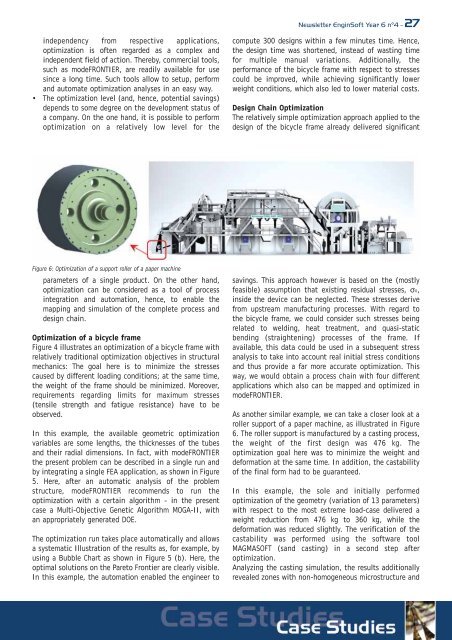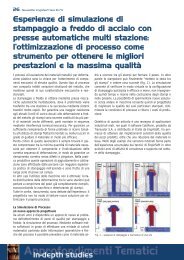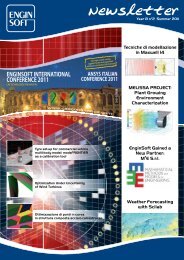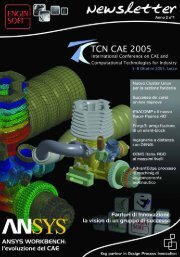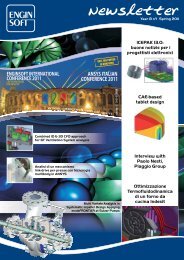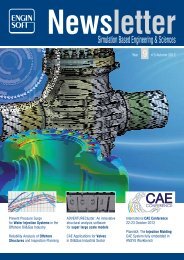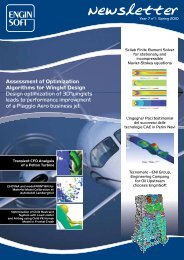software training courses 2010 corsi di addestramento ... - EnginSoft
software training courses 2010 corsi di addestramento ... - EnginSoft
software training courses 2010 corsi di addestramento ... - EnginSoft
You also want an ePaper? Increase the reach of your titles
YUMPU automatically turns print PDFs into web optimized ePapers that Google loves.
independency from respective applications,<br />
optimization is often regarded as a complex and<br />
independent field of action. Thereby, commercial tools,<br />
such as modeFRONTIER, are rea<strong>di</strong>ly available for use<br />
since a long time. Such tools allow to setup, perform<br />
and automate optimization analyses in an easy way.<br />
The optimization level (and, hence, potential savings)<br />
depends to some degree on the development status of<br />
a company. On the one hand, it is possible to perform<br />
optimization on a relatively low level for the<br />
Figure 6: Optimization of a support roller of a paper machine<br />
parameters of a single product. On the other hand,<br />
optimization can be considered as a tool of process<br />
integration and automation, hence, to enable the<br />
mapping and simulation of the complete process and<br />
design chain.<br />
Optimization of a bicycle frame<br />
Figure 4 illustrates an optimization of a bicycle frame with<br />
relatively tra<strong>di</strong>tional optimization objectives in structural<br />
mechanics: The goal here is to minimize the stresses<br />
caused by <strong>di</strong>fferent loa<strong>di</strong>ng con<strong>di</strong>tions; at the same time,<br />
the weight of the frame should be minimized. Moreover,<br />
requirements regar<strong>di</strong>ng limits for maximum stresses<br />
(tensile strength and fatigue resistance) have to be<br />
observed.<br />
In this example, the available geometric optimization<br />
variables are some lengths, the thicknesses of the tubes<br />
and their ra<strong>di</strong>al <strong>di</strong>mensions. In fact, with modeFRONTIER<br />
the present problem can be described in a single run and<br />
by integrating a single FEA application, as shown in Figure<br />
5. Here, after an automatic analysis of the problem<br />
structure, modeFRONTIER recommends to run the<br />
optimization with a certain algorithm - in the present<br />
case a Multi-Objective Genetic Algorithm MOGA-II, with<br />
an appropriately generated DOE.<br />
The optimization run takes place automatically and allows<br />
a systematic Illustration of the results as, for example, by<br />
using a Bubble Chart as shown in Figure 5 (b). Here, the<br />
optimal solutions on the Pareto Frontier are clearly visible.<br />
In this example, the automation enabled the engineer to<br />
Newsletter <strong>EnginSoft</strong> Year 6 n°4 - 27<br />
compute 300 designs within a few minutes time. Hence,<br />
the design time was shortened, instead of wasting time<br />
for multiple manual variations. Ad<strong>di</strong>tionally, the<br />
performance of the bicycle frame with respect to stresses<br />
could be improved, while achieving significantly lower<br />
weight con<strong>di</strong>tions, which also led to lower material costs.<br />
Design Chain Optimization<br />
The relatively simple optimization approach applied to the<br />
design of the bicycle frame already delivered significant<br />
savings. This approach however is based on the (mostly<br />
feasible) assumption that existing residual stresses, σ0,<br />
inside the device can be neglected. These stresses derive<br />
from upstream manufacturing processes. With regard to<br />
the bicycle frame, we could consider such stresses being<br />
related to wel<strong>di</strong>ng, heat treatment, and quasi-static<br />
ben<strong>di</strong>ng (straightening) processes of the frame. If<br />
available, this data could be used in a subsequent stress<br />
analysis to take into account real initial stress con<strong>di</strong>tions<br />
and thus provide a far more accurate optimization. This<br />
way, we would obtain a process chain with four <strong>di</strong>fferent<br />
applications which also can be mapped and optimized in<br />
modeFRONTIER.<br />
As another similar example, we can take a closer look at a<br />
roller support of a paper machine, as illustrated in Figure<br />
6. The roller support is manufactured by a casting process,<br />
the weight of the first design was 476 kg. The<br />
optimization goal here was to minimize the weight and<br />
deformation at the same time. In ad<strong>di</strong>tion, the castability<br />
of the final form had to be guaranteed.<br />
In this example, the sole and initially performed<br />
optimization of the geometry (variation of 13 parameters)<br />
with respect to the most extreme load-case delivered a<br />
weight reduction from 476 kg to 360 kg, while the<br />
deformation was reduced slightly. The verification of the<br />
castability was performed using the <strong>software</strong> tool<br />
MAGMASOFT (sand casting) in a second step after<br />
optimization.<br />
Analyzing the casting simulation, the results ad<strong>di</strong>tionally<br />
revealed zones with non-homogeneous microstructure and


